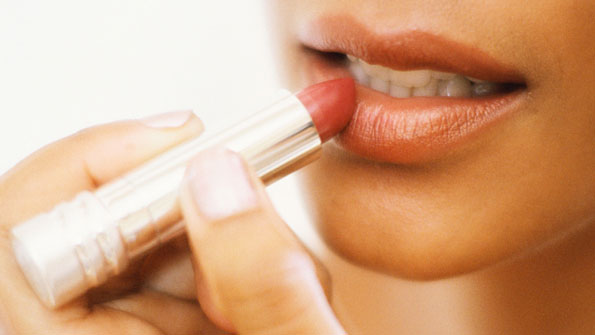A new study shows lead in lipstick is still very much a concern. While natural companies aren’t in the clear, they are in a prime position to raise the bar with industry-wide best practices to keep contaminants out of our cosmetics.

A 2007 study on lead in lipstick revealed a dirty little secret about cosmetics, and a recently released U.S. Food and Drug Administration (FDA) follow up proves that the industry has yet to clean up heavy metal contamination. Lead still taints hundreds of lipsticks—including natural ones. But who’s to blame?
Lead—a heavy metal trace ingredient linked to neurological and reproductive damage—is an industry-wide cosmetics concern. You don’t have to look far down the list of the 400 offending companies to see that contamination can affect any cosmetic manufacturer. Scan the list past major mass-market companies such as L'Oreal and Cover Girl and high-end cosmetic brands such as NARS, and there it is: Burt’s Bees at No. 17.
Unlike with parabens, synthetic fragrances, 1,4-dioxane and other personal care villains that hit mainstream media in recent years, cosmetic manufacturers don’t use lead intentionally to cut costs. It's not a cheap way to give products an appealing scent, brighter hue, longer shelf life or rich lather.
"The main challenge is that lead is inherent in the earth and basically everything on the planet contains some level," said Celeste Lutrario, vice president of global research and development at Burt’s Bees. "Ingredients, especially colorants, are mined minerals and come from the earth."
Lead's presence in rocks and soil makes both conventional and natural makeup manufacturers susceptible to contamination. And many companies in different markets work with the same mineral colorant suppliers, according to Lutrario.
Who is to blame for lead contamination?
While the worst offenders such as L'Oreal (dominating five of the 10 top spots with products containing significantly more lead than in the initial 2007 study) are apparent, lead is “a challenge for the whole industry,” said Stacy Malkan, director of the Campaign for Safe Cosmetics, who has urged the FDA to set a maximum lead in cosmetics limit since the Campaign released a 2007 report on the issue.
“The government didn’t regulate [lead] for years and years—kept it in paint, kept it in gas, in kids' rooms and hospitals. There’s a long history of resisting legislation that has gotten us in a bad place. It’s a cautionary tale that we have to regulate toxic substances,” she said.
The FDA now enforces maximum lead levels for food such as candy and juice, but keeps the ubiquitous heavy metal unregulated in cosmetics, including in commonly ingested lipstick. The FDA maintains that lead isn’t dangerous in “topical-use” products, but issued a statement saying it will continue evaluating whether an upper limit for lipstick is needed.
In the meantime, retailers and consumers have no way to avoid it in a range of cosmetics.
For this latest industry snapshot, the FDA chose products to test primarily based on the parent company’s market share, making Burt’s Bees, the Clorox-owned brand with far-reaching mass and natural retail distribution, among the few natural companies to come under fire.
“It’s a question mark what levels of lead would we would find in [other] natural brands,” Malkan said.
Best practices for natural cosmetics companies
In the past, Burt’s Bees calculated lead content based on its suppliers’ data to formulate in compliance with California’s Proposition 65, a state law that says lipsticks sold in California containing 5 parts per million (ppm) of lead must include that information on the label with a warning statement.
After the brand’s savvy consumers have responded to the study with questions about lead levels, the company plans to make some adjustments. While Lutrario notes that mineral colorants will continue to be the company's go-to for strong, vibrant, lasting hues (rather than fruit and vegetable pigments, for example), other processes can help prevent contamination. “In light of this [FDA] study we are going to test all of our lip color finished products,” Lutrario said.
That’s a practice Denver-based mineral makeup company Mineral Fusion has abided by for two years, and “at a moment like this, we are so glad we did,” said Tim Schaeffer, senior vice president of marketing.
Mineral Fusion builds the foundation for lead-free products by starting with “boutique” suppliers that use a process called scrubbing to reduce contaminants. “We look for raw material suppliers that have a protocol ensuring the overall quality beyond lead,” Schaeffer said.
Mineral Fusion then sends each finished lip color product out for third-party testing. “As a small boutique company we’re able to do it; so if we are able to test our products, everyone can,” he said.
Responsible manufacturing and testing practices will help the natural products industry to come together to find the lowest achievable lead levels for cosmetics, said Malkan.
Leading the way for legislation
The Campaign for Safe Cosmetics continues to push back against companies such as L’Oreal that are showing no improvements and therefore aren’t in a place to recommend “safe” levels.
“What are the best practices for keeping lead out of cosmetics? What are the lowest levels that companies can achieve? That’s how we’re asking FDA to approach this, rather than looking at some level of lead they think is safe but is totally arbitrary,” Malkan said.
A manufacturer’s due diligence is just one aspect of changing the system. Schaeffer and Lutrario agree that determining safe levels requires research beyond the natural products industry, testing and ultimately FDA enforcement.
In addition to making some internal changes such as sending products out for testing, Burt’s Bees is working with the Natural Products Association and European natural and organic cosmetics certifier NaTrue to join with other cosmetics companies to recommend a maximum lead limit to the FDA.
“I think that the natural products industry has an opportunity here to come to a consensus about best practices,” Malkan said.
About the Author(s)
You May Also Like




